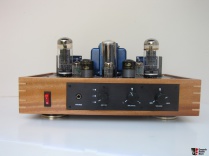COMING SOON
High Fidelity Radio Streams
Invitation Only for Audiophiles
320KBPS
Sign up for the Waiting List
True Audiophile: New Products
ELAC Carina Bookshelf Speaker OPEN BOX (Tue, 16 Jul 2024) ELAC Astonishing Carina Speaker with its Folded Jet Tweeter. Striking looks. Breathtaking sound by Andrew Jones
Now at True Audiophile.
$700.00
ELAC Astonishing Carina Speaker with its Folded Jet Tweeter. Striking looks. Breathtaking sound by Andrew Jones
Now at True Audiophile.
$700.00 
>> Read more
Asimi Speaker Z/S/E Luxe. Superior Contact (Mon, 15 Jul 2024)
 Asimi Speaker Z/S/E Luxe. Superior Contact
Now at True Audiophile cable products
No excuses - these are not inexpensive. However, if you hear them you will not be able to forget them. The finest speaker cables we ever heard --
Mi..
Price: $13,920.00
Asimi Speaker Z/S/E Luxe. Superior Contact
Now at True Audiophile cable products
No excuses - these are not inexpensive. However, if you hear them you will not be able to forget them. The finest speaker cables we ever heard --
Mi..
Price: $13,920.00 
>> Read more
Atlas Eos Modular Power Block 4.0 (Mon, 15 Jul 2024)
 Atlas Eos Modular Power Block 4.0
Now at True Audiophile cable products
Atlas has continuously impressed us. Their special grounding feature is stunning in how quiet and black it makes these cables. Here's their version of a grounding block that does just
that..
Price: $1,199.00
Atlas Eos Modular Power Block 4.0
Now at True Audiophile cable products
Atlas has continuously impressed us. Their special grounding feature is stunning in how quiet and black it makes these cables. Here's their version of a grounding block that does just
that..
Price: $1,199.00 
>> Read more
AirTight ATM-2211 Superior 211 amplifier (Fri, 21 Jun 2024)
 AirTight ATM-2211 Superior 211 Amplifier. High Demand.
At True Audiophile
If your goal is to have the a superb 211 in the fanatical build level of AirTight, Then this is your mono blocks. -- Mini Review by True
AudiophilePrice: $39,975.00
AirTight ATM-2211 Superior 211 Amplifier. High Demand.
At True Audiophile
If your goal is to have the a superb 211 in the fanatical build level of AirTight, Then this is your mono blocks. -- Mini Review by True
AudiophilePrice: $39,975.00 
>> Read more
Description of news story.









